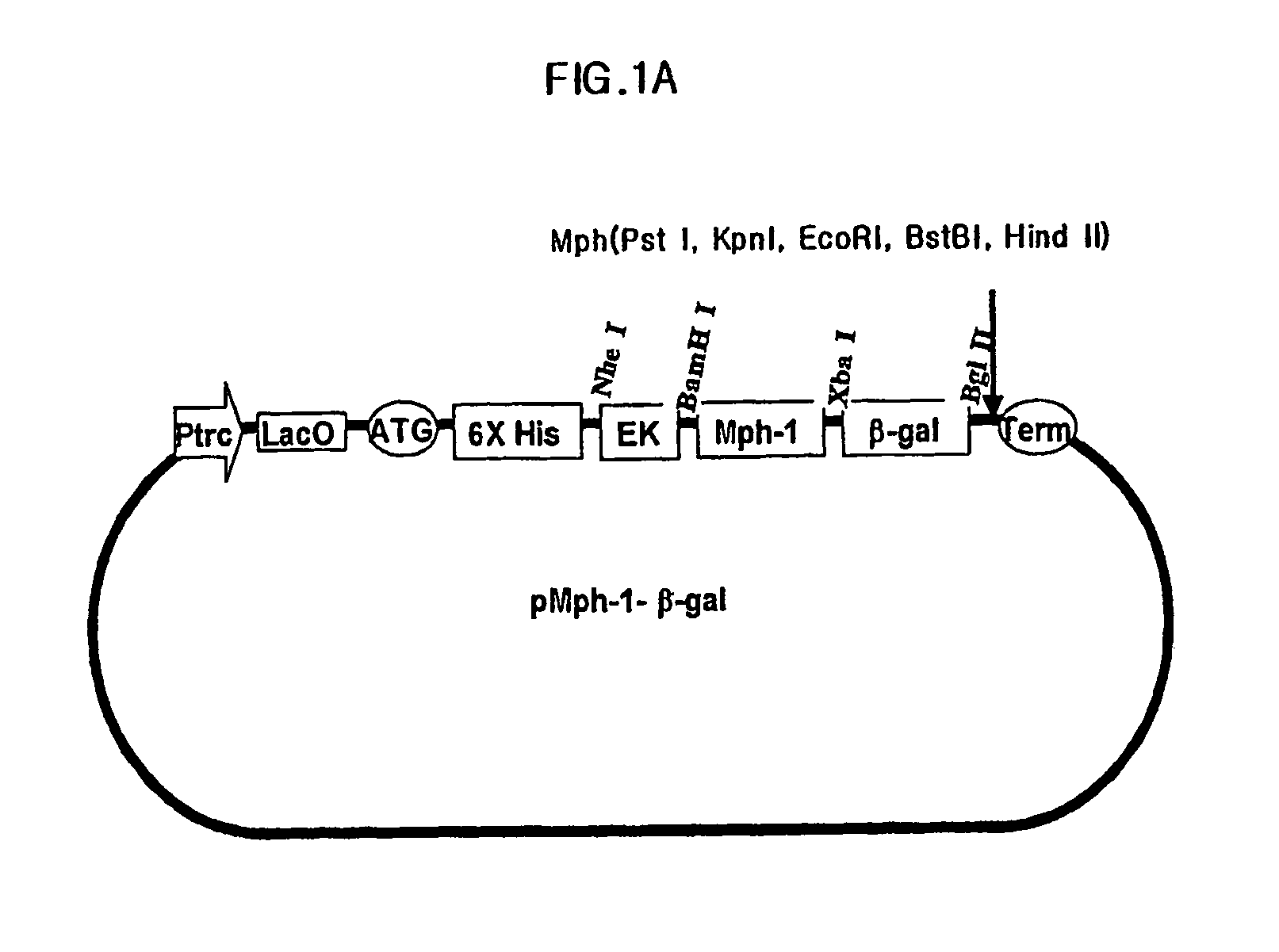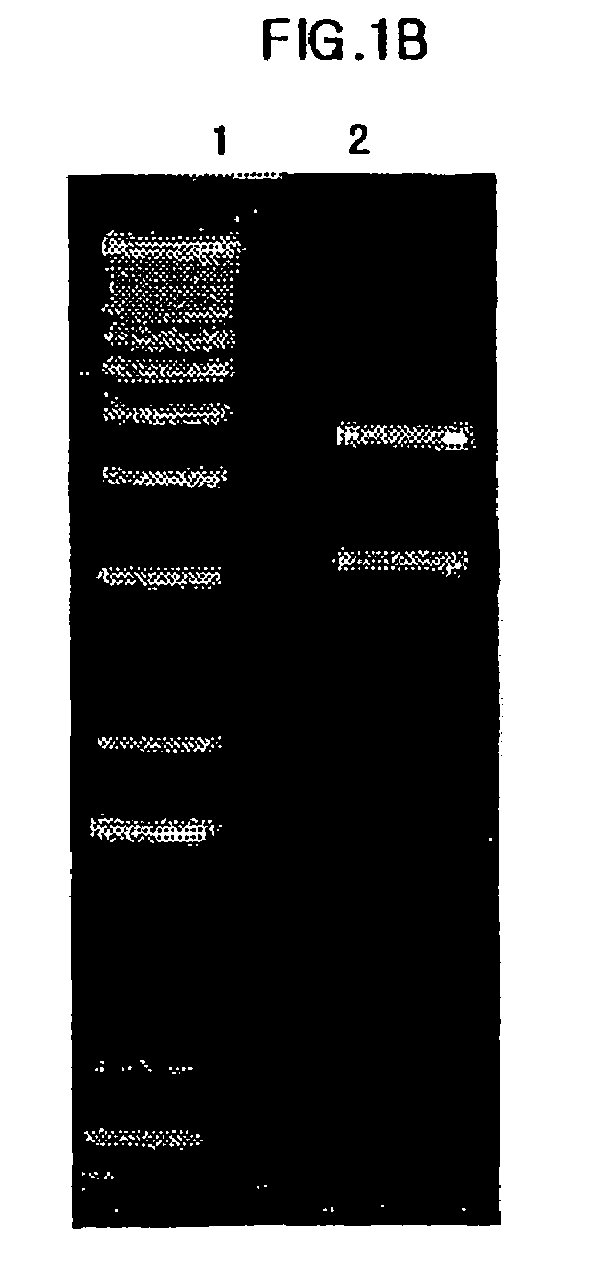Biomolecule transduction motif Mph-1-BTM and the use thereof
a biomolecule and transduction motif technology, applied in the field of mph1 biomolecule transduction motif, can solve the problems of side effects on other cells, insufficient efficacy to be applied clinically, and restricted research to develop drugs
- Summary
- Abstract
- Description
- Claims
- Application Information
AI Technical Summary
Problems solved by technology
Method used
Image
Examples
example 1
Preparation of Expression Vector Including Mph-1-BTM of Biomolecule Transduction Peptide
[0067]Nucleic acid sequence encoding peptide corresponding to amino acids from 858th of Tyrosine to 868th of Arginine from N-terminus mouse transcription factor of Mph-1 (GeneBank Code: U63386) was combined with the nucleic acid sequence encoding reporter protein of β-galactosidase. In order to do this, firstly, a primer of SEQ ID NO:2 containing the nucleic acid sequence encoding peptide corresponding to amino acids from 858th of Tyrosine to 868th of Arginine from N-terminus of Mph-1 and BamHI site for cloning, and a primer of SEQ ID NO:3 containing nucleic acid sequence of 3′ terminus of β-galactosidase and restriction enzyme of Bgl II site for cloning were synthesized. Then, PCR was carried out using pIND / lacZ vector (Invitrogen corp.), as a template, with pfu turbo DNA polymerase (Stratagene, cat.# 600252-51). After digesting the PCR products with restriction enzymes of BamHI and Bgl II, the ...
example 2
Preparation of E. Coli Transformant, and Expression and Isolation of Fusion Protein Therefrom
[0068]DH5α(ATCC No. 53863) was transformed using pMph-1-β-gal of the Example 1 by heat shock transformation. 2 ml of the transformants were transferred to 100 ml of LB medium, and pre-incubated for 12 hrs at 37° C. with agitation. Then, the pre-incubated transformants were inoculated to 1000 ml of LB medium (10 g of pancreatic digests of casein, 5 g of yeast extract, 10 g of sodium chloride) and were incubated for 4 hrs at 37° C. Following the incubation, 1 mM of IPTG (Isopropyl β-D-thiogalactosipyranoside, GibcoBRL cat.# 15529-019) was added in order to induce the expression of lac operon, and then incubated again for 8 hrs to elicit expression of the fusion protein. Next, the cell culture solution was centrifuged at 6,000 rpm for 20 min at 4° C. After removing the supernatant, resultant pellet was dissolved in 10 ml of buffer solution 1 (50 mM of NaH2PO4, 300 mM of NaCl, 10 mM of Imidazole...
example 3
Transduction of Fusion Protein Across Cell Membrane
[0069]HUVEC (ATCC:CRL-1730) (2×105), HeLa (ATCC:CCL-2) (2×105), and 293 (ATCC:CRL-1573) (2×105), which were incubated in 10% FBS (Fetal Bovine Serum) of DMEM, were respectively transferred to Lab-tek II chamber slides. Jurkat cells (ATCC:CRL-10915) (2×105) incubated in 10% EBS RPMI were transferred to poly-L-lysin coated slides. Each of the slides was treated with the purified 0.5 μM of Mph-1-β-galactosidase for 30 min at 37° C. in 5% CO2 incubator. And the supernatants were removed from the slides. The incubation mixtures were washed using ice-cold PBS four times and then were solidified with 2% formaldehyde solution for 10 min. After removing the solidified solutions, the mixtures were washed again using ice-cold PBS four times. Subsequently, the respective mixtures were treated with 700 μl of β-galactosidase staining solution (Roche. Colo.) for 45 min at 37° C. in 5% CO2 incubator. Following the staining, the mixtures were washed...
PUM
| Property | Measurement | Unit |
|---|---|---|
| pH | aaaaa | aaaaa |
| nucleic acid sequence | aaaaa | aaaaa |
| Fluorescent | aaaaa | aaaaa |
Abstract
Description
Claims
Application Information
 Login to View More
Login to View More - R&D
- Intellectual Property
- Life Sciences
- Materials
- Tech Scout
- Unparalleled Data Quality
- Higher Quality Content
- 60% Fewer Hallucinations
Browse by: Latest US Patents, China's latest patents, Technical Efficacy Thesaurus, Application Domain, Technology Topic, Popular Technical Reports.
© 2025 PatSnap. All rights reserved.Legal|Privacy policy|Modern Slavery Act Transparency Statement|Sitemap|About US| Contact US: help@patsnap.com



